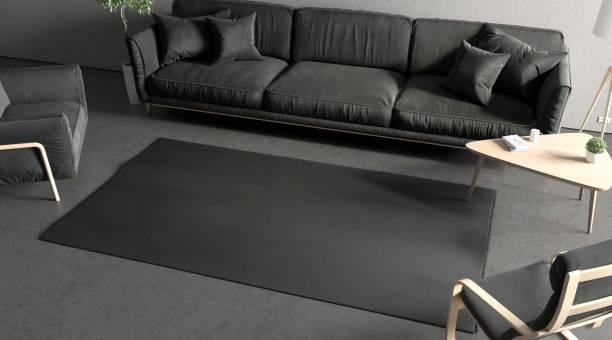What is the layering of rugs in home décor
In-home decor layering rugs are placing several rugs on each other to create an interesting texture and visual appeal. This involves layering rugs with different patterns, colors, textures, and sizes to give room depth and personality.
Using multiple rugs to create a unique and stylish look can enhance the ambiance and style of any space.
Consider these key factors when layering rugs
Size and placement: Choose a large rug to anchor the room. It will also provide a solid foundation. The second, smaller rug is then placed on top. You can center it or set it off-center to create an intentional asymmetry.
Contrasting Patterns and Textures: Select rugs with polar patterns, colors, textures, or other features to add visual interest. You could pair a carpet in a solid color with one with a design or a fluffy rug that is textured with a flat-woven given.
Complementary colors: Consider the color scheme in the room, and select rugs that harmonize or complement the decor. Choose complementary colors for a vibrant and bold look. Or choose rugs with a similar palette of colors for a more coordinated and cohesive feel.
Experimenting with materials and textures: Add depth and tactile appeal by layering different materials. Layer a sisal or jute rug with a plush and soft carpet to create a mixture of natural elements.
When layering rugs, keep in mind visual hierarchy. The base layer should be large and neutral for a solid foundation. The top layer can be small and eye-catching.
Rug Pads: Use rug pads to cushion the rugs and prevent them from slipping.
It is possible to create a stunning look by layering rugs in any room, including the family room, bedroom, foyer, and entryway (in some instances). This adds warmth and texture to the room while allowing your creativity and style to be displayed. Your home’s overall feel and look can be transformed by experimenting with different combinations of carpets and rugs.
Do people use area rugs to cover carpets
People often layer area carpets over carpets to add warmth, style, and visual interest to the room. Interior design techniques such as layering rugs on top of carpets are popular. This allows people to customize their home decor, introduce different textures, and create a focal piece.
The benefits of layering area rugs on top of carpets are numerous
Style and aesthetics: By layering the rugs, you can introduce new patterns, colors, and textures to complement or contrast the carpet. This will help to break up a large carpeted space and add visual interest.
Definition of Spaces – Layering rugs is a great way to create zones or areas in large, open rooms or floor plans. Place an area rug, for example, under a table or seating arrangement to visually separate the space from carpeted areas.
Add a soft or plush area rug to a carpeted surface for warmth and comfort. This is particularly beneficial in colder climates and during winter when carpeting may feel less inviting.
Protection and Versatility – Layering rugs on top of carpets will protect the carpet beneath by providing a barrier to spills, stains, or heavy foot traffic. It also offers versatility as you can change the look or feel of a space by changing or rearranging top layer rugs.
You can express your personality and style by layering rugs on top of carpets.
What interior design method works best for layering rugs
Depending on the desired look and style of the space, layering rugs over other rugs may work for different interior design styles. Overlapping rugs can be used as a home decor technique to suit many aesthetics.
These interior design techniques can make it more effective to layer rugs on top of area rugs
Eclectic design is a popular way to layer rugs. The eclectic design embraces different styles, patterns, and textures. Eclectic rooms often feature unexpected combinations and bold colors. You can play with different patterns, colors, and textures by layering rugs. This will add visual interest to your space and create a global or bohemian look.
Modern Design: Layering rugs is a great way to achieve a modern design, particularly if you aim for a minimalistic and streamlined aesthetic. Layering rugs in contemporary spaces can add texture and depth to a room that is otherwise sleek and clean. Choose rugs in solid or subtle colors and patterns complimenting the color scheme. Keep the layering minimal to achieve a more subdued look.
Layering rugs is not as common in traditional design, but it can be used to add visual intrigue and unique touch. Layering rugs will enhance the rich textures and intricate designs often found in traditional spaces. Layering rugs that feature classic motifs and ornate detailing is a great way to add depth and texture.
Bohemian Design – Layering rugs have become a boho or bohemian design hallmark. Bohemian interiors are eclectic and free-spirited. They encourage the mixing and matching of different elements. You can create a relaxed and cozy atmosphere by layering rugs with different sizes, textures, and patterns. Vibrant colors, ethnic patterns, and natural materials characterize the bohemian style.
Transitional Design: This design combines elements from both traditional and modern styles. In transitional spaces, layering rugs can help bridge the gap between traditional and contemporary aesthetics. Select rugs with a mix of traditional and modern patterns or materials. This can create visual interest as well as a smooth transitional look.
You must approach the design of layering area rugs on top of other rugs with intentionality and a sense of balance. The combination of area rugs should enhance the overall design. Size, color coordination, and pattern compatibility are all important factors. Combining multiple styles of area rugs and types of rugs will help you achieve the layered rug style that best suits your interior design.

